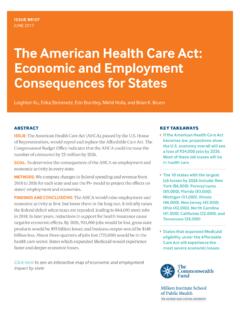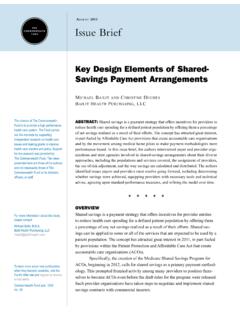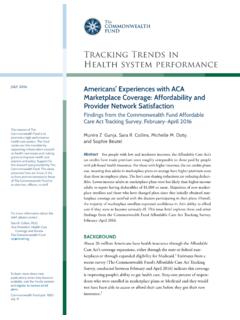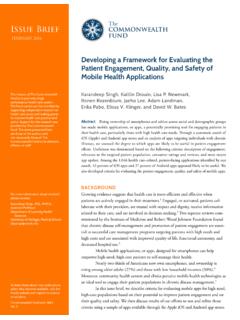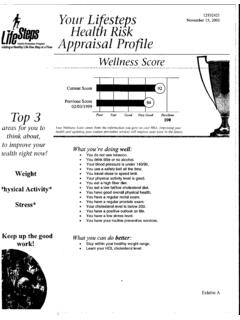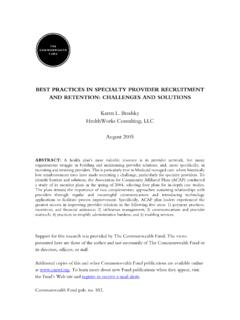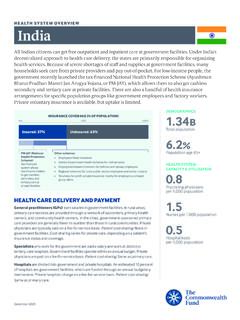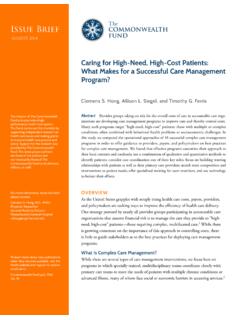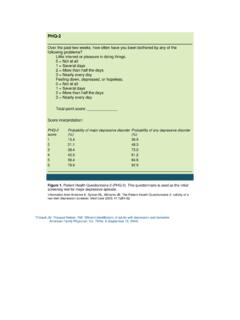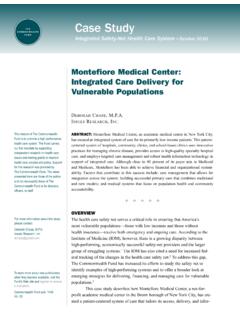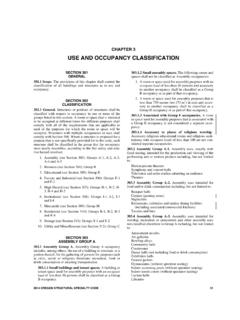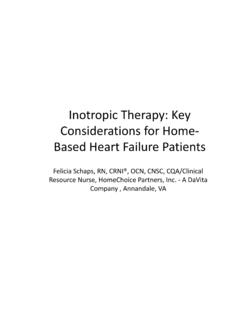Transcription of Achieving Efficiency: Lessons from Four Top …
1 For more information about this study, please contact:Jennifer N. Edwards, Management download this publication and learn about others as they become available, visit us online at and register to receive Fund e-Alerts. Commonwealth Fund pub. 1528 Vol. 15 The mission of The Commonwealth Fund is to promote a high performance health care system. The Fund carries out this mandate by supporting independent research on health care issues and making grants to improve health care practice and policy. Support for this research was provided by The Commonwealth Fund. The views presented here are those of the authors and not necessarily those of The Commonwealth Fund or its directors, officers, or n. edwards, sharon silow-Carroll, and aimee lashbrook health management assoCiates SUMMARYD espite widespread acknowledgment of waste and inefficiency in the health care system, there have not been dramatic breakthroughs that point the way to more cost-effective alternatives.
2 The problems that contribute to high costs and mediocre quality are complex and intertwined with the organization and financ-ing of health services. There are, however, changes under way within leading organizations that suggest significant improvements in quality and value can be achieved. In 2008, the Leapfrog Group s Hospital Recognition Program began identifying hospitals that have made big leaps in health care safety, quality, and customer value. 1 Thirteen hospitals out of nearly 1,300 who voluntarily submit-ted data in 2008 achieved top scores in quality of care while keeping resource use low. To learn what opportunities exist for all hospitals to achieve greater effi-ciency, we conducted case studies of four of the 13 Leapfrog Group designated Highest Value Hospitals. These included Fairview Southdale Hospital in Edina, Minn.
3 , North Mississippi Medical Center in Tupelo, Miss., Park Nicollet Methodist Hospital in St. Louis Park, Minn., and Providence St. Vincent Medical Center in Portland, Ore. This paper offers a synthesis of Lessons from their site visits conducted in 2010, we asked hospital leaders and staff about the activities they credit with having contributed to high quality and low resource use, not just measures used in the Leapfrog recognition program. In each case, the hospital described myriad programs they had undertaken in the past few years that did not target efficiency but had indirectly contributed to it. A number of commonalities emerged. All of the hospital leaders had set clear goals for their organizations and aligned daily practice with those objec-tives. They employed widely used quality improvement strategies such as moni-toring and reporting quality indicators against benchmarks to motivate providers and focus improvement resources.
4 Each hospital also used technology to test Achieving Efficiency: Lessons from Four Top-Performing HospitalsSynthesis Report July 20112 the Commonwealth fundimprovement tools and provide staff with longitudinal patient information that they might use to monitor their progress. All four of the hospitals had begun to shift a larger portion of patient care responsibility from com-munity physicians toward a smaller team of hospital-ists who are accessible full-time and can be more eas-ily trained to adhere to best-practice guidelines. Each hospital had also recently reorganized at least a portion of its staffing assignments and roles to align provider skills and staffing levels more effectively with patient needs. In addition, all four hospitals had worked on improving provider communication during handoffs between hospital departments and transitions between inpatient and outpatient care.
5 While technology was a part of the revised processes, more complete commu-nication, including frequent face-to-face contact, was also deemed integral to its both clinical and support services, staff of these institutions standardized and simplified processes to eliminate redundancy, slowdowns in patient flow, and errors. At least one of the hospitals went outside the health care sector for models of managing labor costs, standardizing and tracking supplies, and pur-chasing in it was not a selection criterion for this study, each hospital was part of an integrated system with certain features that support efficiency, including access to patient information across settings and over time, economies of scale, opportunities to share best practices, and greater potential for aligning inpatient and outpatient goals.
6 In integrated systems, reduced hospital admissions and readmissions do not hurt the bottom line to the extent they do in freestanding environmental factors motivating the hospi-tals efficiency efforts were not uniform. Some hospi-tals were in competitive marketplaces that pushed them to improve, but one was the dominant provider in half of its state. Cost pressures were observed everywhere. And while most of the improvements were undertaken in the middle part of this past decade, the economic downturn since 2008 had increased the deliberateness with which each hospital was seeking to maximize sum, the experiences of the four case study hospitals offer the following Lessons for hospitals seek-ing to increase efficiency: Pursue quality and access, and efficiency will improve. Case study hospitals reported that cost reduction was the consequence, not the primary goal, of their efforts.
7 Reinforce goals by addressing organizational cul-ture through communication, clinical leadership, alignment of purpose, and celebration of success. Implement quality improvement strategies such as close monitoring of performance indicators against benchmarks to motivate physicians and frontline staff and promote a culture of continuous quality improvement. Use technology including electronic medical records that are customized to the hospital s con-figuration and needs as tools to improve quality and efficiency. Manage staffing and adjust roles to reduce or improve handoffs and promote teamwork to meet patient needs, including reassessing traditional boundaries that contribute to faulty handoffs between personnel. Use full-time, on-site physi-cians such as hospitalists, as well as team leaders, to coordinate services and enhance continuity.
8 Emphasize communication among providers and with families to clarify expectations and improve patient transitions throughout sites of care. Standardize processes and supplies to reduce the opportunity for errors and increase purchasing power. Integrate care, systems, and providers, either explicitly in an integrated health system or by adopting the characteristics of an integrated care system within a community (for instance, by shar-ing a common information system). Achieving effiCienCy: Lessons from four top-performing hospitals synthesis report 3 Federally supported health system reforms pro-mote changes that are consistent with these leading hospitals experience, including greater use of health information technology, care coordination, and pay-ment reforms that incentivize inpatient and outpatient care coordination and promote quality.
9 As a result of the health reform law, hospitals will have both greater responsibility and opportunity to implement these broad changes. INTRODUCTIONP ublic and Purchaser Approaches to Enhancing Efficiency Rising costs and evidence of waste have led purchas-ers including employers, consumers, and governmental agencies to demand that health plans and providers improve the value of health care. Exact estimates vary, but analysts point to inefficiencies in administration, operations, and clinical care totaling billions of dollars per year. Peter Orszag, former director of the Congressional Budget Office, stated in August 2008 that a variety of credible evidence suggests that health care contains the largest inefficiencies in our economy. As much as $700 billion a year in health care services are delivered in the United States that does not improve health outcomes.
10 2 Insurers, managed care organizations, and health plans are pressuring hospitals, physicians, and other care providers by reducing or constraining the growth in reimbursement rates, and threatening to not pay for care that is unsafe or unnecessary. In order to survive, these providers must find ways to improve efficiency by reducing their resource, administrative, and labor costs without sacrificing quality. The Institute for Healthcare Improvement (IHI), a leader in quality improvement research and practice, incorporated the need to increase efficiency into one of its core teaching concepts the Triple Aim. The Triple Aim calls for developing new designs and initiatives to: 1) improve the health of the population; 2) enhance the patient experience of care (including quality, access, and reliability); and 3) reduce, or at least con-trol, the per capita cost of has been working with hospitals and other organizations around the and the world to imple-ment design changes to achieve the Triple Aim.
